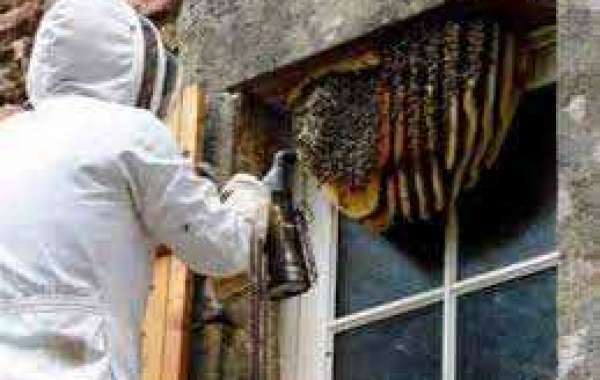Carpenter bees, often mistaken for bumblebees, pose a unique threat to wooden structures. Unlike termites that eat wood, carpenter bees excavate tunnels in wood to create nests. These bees are particularly fond of untreated, exposed wood commonly found in sidings, decks, outdoor furniture, and eaves. While they are not aggressive by nature, the damage they cause can be significant over time. Identifying and addressing a carpenter bee infestation is crucial to prevent structural damage and maintain the integrity of your property.
The challenge with carpenter bees lies in their nesting habits. They tend to return to the same nesting sites year after year, expanding tunnels and creating more room for their larvae. This repeated burrowing weakens the wood and can lead to costly repairs. Therefore, early detection and effective extermination are essential in managing carpenter bee populations and safeguarding your property.
Signs of Carpenter Bee Infestation
- Visible Holes: Perfectly round, dime-sized holes in wood structures are a clear sign.
- Sawdust: Accumulations of sawdust beneath wooden items indicate active drilling.
- Buzzing Sounds: A distinct buzzing noise inside woodwork can signal carpenter bee activity.
- Hovering Bees: Male carpenter bees are often seen hovering near wooden structures.
- Stains on Wood: Yellowish stains around entry holes caused by bee waste.
Effective Carpenter Bee Extermination Methods
The process of exterminating carpenter bees involves a combination of chemical treatments and physical alterations to the affected areas. Insecticidal dust is one of the most effective treatments, as it can be applied directly into the tunnels to eliminate the bees and their larvae. This method ensures that the insecticide reaches deep inside the nest, offering a more comprehensive solution.
Another effective method is the use of residual liquid insecticides. These can be sprayed onto the surface of wood where bees are active, deterring them from nesting. However, chemical treatments should be handled with care, preferably by professionals, to ensure safety and effectiveness.
Preventive Measures to Deter Carpenter Bees
Prevention is key in the long-term management of carpenter bee infestations. Treating wood with stains or paints is an effective deterrent, as carpenter bees prefer bare, untreated wood. Regular maintenance and inspections of wooden structures are also crucial. Sealing any existing holes after treatment can prevent bees from reusing old nests, a common practice for these insects.
Additionally, installing physical barriers, such as wire mesh or metal flashing, over vulnerable areas can physically block bees from accessing potential nesting sites. These preventive measures, coupled with regular monitoring, can significantly reduce the likelihood of future carpenter bee infestations.
Choosing the Right Extermination Professional
When selecting a professional for carpenter bee extermination, it's important to choose someone with specific experience and knowledge in dealing with these pests. A licensed and reputable pest control service will have the right tools and techniques to effectively eliminate carpenter bees without causing harm to your property or the environment. Check for reviews, ask for references, and ensure they adhere to safety standards. A good professional will not only remove the current infestation but also provide advice on preventing future issues.
Natural and Non-Chemical Control Methods
For those seeking a more environmentally friendly approach to carpenter bee control, natural and non-chemical methods can be considered. These might include using natural repellents like citrus oil or almond oil, which can deter carpenter bees from nesting. Physical barriers, such as installing wire mesh over drill holes, can also prevent carpenter bees from entering wood surfaces. While these methods are safer for the environment, they may require more diligence and regular application to be effective.
Post-Extermination Care and Maintenance
After the extermination of carpenter bees, it's crucial to undertake proper care and maintenance of the affected areas to prevent re-infestation. This includes sealing all the holes made by the bees with wood putty or a similar substance to discourage future nesting. Applying protective paint or varnish to untreated wood surfaces can also deter carpenter bees. Regular inspections of wood structures, especially during the spring when carpenter bees are most active, are essential to catch any new activity early.
Understanding Carpenter Bee Behavior for Effective Control
A deeper understanding of carpenter bee behavior is key to effective control and prevention. Carpenter bees prefer bare, unpainted, or weathered softwoods for nesting. They are solitary bees, and each female bee tends to her own nest. Recognizing the signs of their presence, such as the distinct round entry holes and sawdust-like frass, can help in early detection and prevention of infestations. Understanding their seasonal patterns can also aid in timing preventive treatments for maximum effectiveness.
Concluding Thoughts on Carpenter Bee Extermination
In conclusion, while carpenter bees are not typically aggressive towards humans, their ability to damage wood structures makes them a pest that should be addressed promptly. Professional extermination, combined with preventive measures and regular maintenance, is the most effective way to manage carpenter bee infestations. Understanding their behavior and habitat preferences can also aid in developing strategies to deter them from nesting on your property. By taking proactive steps and seeking professional help when needed, homeowners can protect their properties from the damage caused by these wood-boring bees, preserving the integrity and aesthetics of their wooden structures for years to come.










